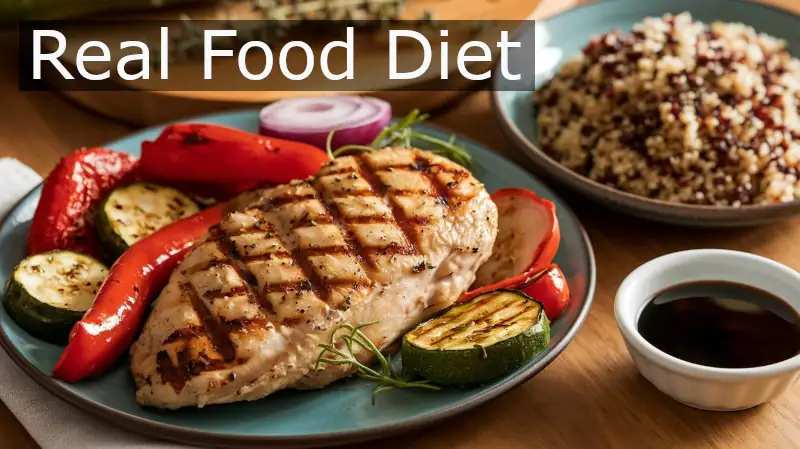Conquer Inflammation: Your 7-Day Anti-Inflammation Diet for Beginners
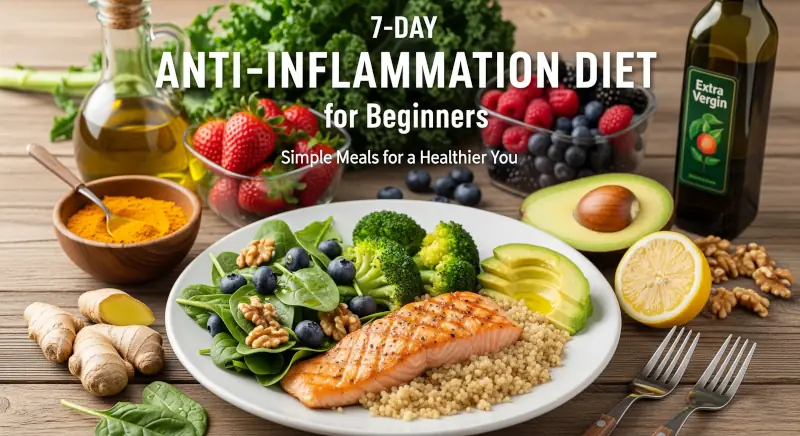
Get ready to feel better, more energized, and truly well! If you’ve been feeling tired, achy, or just not your best, you might be wondering what’s really going on inside your body. Sometimes, these nagging feelings are signs of something called chronic inflammation. It’s not the kind of inflammation you get from a cut or bruise that heals quickly; instead, it’s a long-term, low-grade kind of irritation that can affect your whole body and make you feel unwell. But here’s the good news: you have the power to make a big difference simply by changing what you eat!
This article is your friendly guide to starting a new journey towards better health with a 7-day anti nflammation diet for beginners. We’re going to explore how certain foods can help calm down that internal fire and how a simple, delicious eating plan can make a world of difference. Designed by a registered dietitian, this plan offers simple, healthy recipes with shorter ingredient lists, making it easy to jump-start your health journey and build your confidence in the kitchen, even on your busiest days. Are you ready to discover how amazing you can feel? Let’s get started!
Understanding the Anti-Inflammatory Lifestyle: Foods to Embrace and Avoid
Embarking on an anti-inflammatory journey means shifting your focus to foods that nourish and heal your body, rather than those that might stir up trouble. Think of your plate as a canvas, and you’re painting it with vibrant, wholesome ingredients that work hard to reduce inflammation. This isn’t about complicated rules or deprivation; it’s about choosing better, simpler foods that make you feel good.
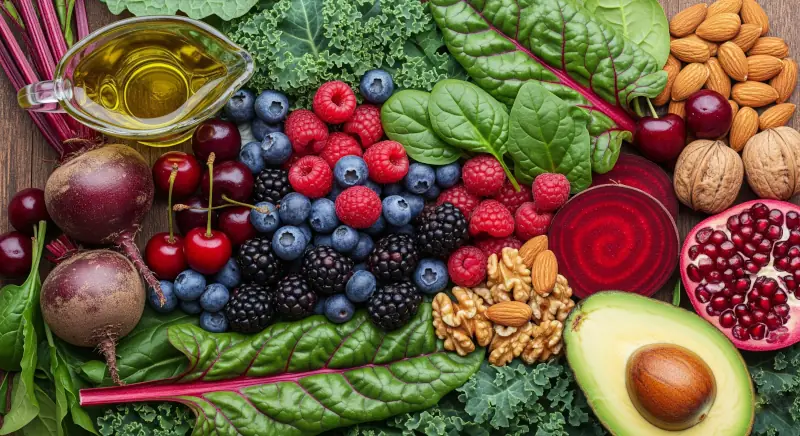
When you follow an anti-inflammatory eating style, you’re choosing to fill your plate with foods known to help your body feel its best. This means focusing on a colorful array of fruits, vegetables, whole grains, and healthy fats. These are the superstars that will help you tackle inflammation head-on.
Let’s look at some of the key players you’ll want to invite to your table:
- Dark Leafy Greens: Think spinach and kale. These greens are packed with good stuff that fights inflammation.
- Berries: Blueberries, raspberries, and blackberries are not just delicious; they’re loaded with antioxidants.
- Cherries and Pomegranates: These vibrant fruits also bring powerful anti-inflammatory benefits to the table.
- Beets: This root vegetable adds a lovely color to your meals and contributes to reducing inflammation.
- Olive Oil and Avocados: These are your go-to sources for healthy fats, which are super important for fighting inflammation in your body.
- Nuts: Especially walnuts and almonds, these provide healthy fats and other beneficial nutrients.
Why are these foods so good for you? It all comes down to their amazing nutrients:
- Antioxidants: These are like little bodyguards that protect your cells from damage. You’ll find them in orange veggies (like sweet potatoes) as beta-carotene, in broccoli and Brussels sprouts as glucosinolates, and in red, blue, and purple fruits (like berries and cherries) as anthocyanins.
- Fiber: Many anti-inflammatory foods are rich in fiber, which helps keep your blood sugar steady. When your blood sugar doesn’t spike too high, it helps reduce inflammation.
- Complex Carbohydrates and Legumes: Foods like whole grains (think whole-wheat bread and gnocchi) and beans (like cannellini beans and lentils) provide sustained energy and fiber, which are important for an anti-inflammatory lifestyle.
By choosing these foods, you’re not just reducing inflammation; you’re also protecting yourself against serious health issues like cancer and heart disease. It’s a win-win for your taste buds and your well-being!
Foods to Limit or Avoid
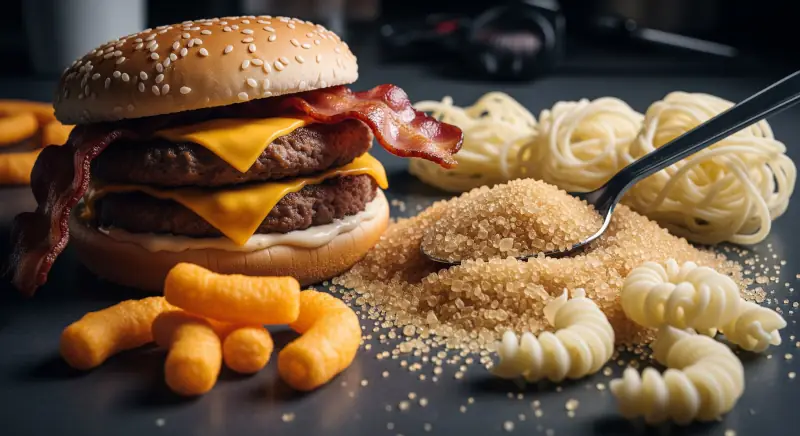
Just as there are foods that help, there are also some that can make inflammation worse. The goal of this healthy diet is to reduce chronic inflammation in the body. So, to help your body feel its best, it’s a good idea to limit or avoid:
- Processed Foods: These often contain ingredients that can trigger inflammation.
- Excess Added Sugars: Too much sugar can be a big culprit in increasing inflammation.
- Refined Grains: Foods like white bread and white flour have had many of their beneficial nutrients stripped away, and they can contribute to blood sugar spikes.
- Red Meat: While you don’t have to cut it out entirely, it’s best to limit red meat to once or twice a week.
By making these simple swaps and choices, you’re setting yourself up for a healthier, happier you. This inflammation diet for beginners is all about nourishing your body with delicious, healing foods.
Your 7-Day Anti-Inflammation Diet for Beginners Meal Plan Overview
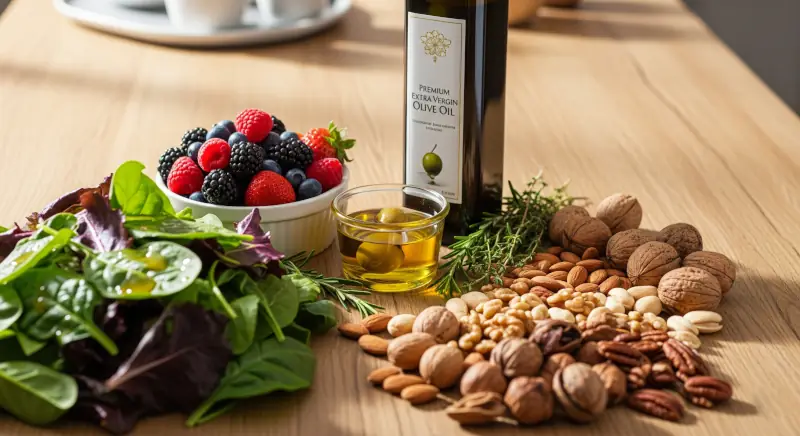
Ready to put this knowledge into action? This 7-day anti-inflammation diet for beginners meal plan is designed to be your easy-to-follow guide to a week of delicious, inflammation-fighting meals. Created by a dietitian, this plan prioritizes anti-inflammatory foods like fruits, vegetables, whole grains, and healthy fats. It focuses on simple recipes with shorter ingredient lists, making meal preparation a snap, even on your busiest days.
Plan Basics for Your Anti-Inflammation Diet for Beginners
This meal plan is carefully crafted to ensure you’re getting the right nutrients without feeling hungry.
- Calorie Level: The plan is generally set at 1,500 calories per day, with clear modifications if you need to aim for a 2,000-calorie intake. This flexibility helps you tailor the plan to your individual needs.
- Nutrient Powerhouse: Each day provides at least 54 grams of protein and 31 grams of fiber. These two nutrients are super important because they help you feel full and satisfied, which is key to sticking with any healthy eating plan.
- What You Won’t See: You won’t find processed foods, excess added sugars, refined grains (like white bread and white flour), or red meat more than once or twice a week in these recipes.
Let’s dive into what a week of anti-inflammatory eating looks like!
Daily Snapshot: Delicious Meals to Combat Inflammation
Here’s a glimpse of the tasty meals you’ll enjoy throughout your week, showing you how simple and satisfying an inflammation diet for beginners can be.
Day 1: Starting Fresh and Strong
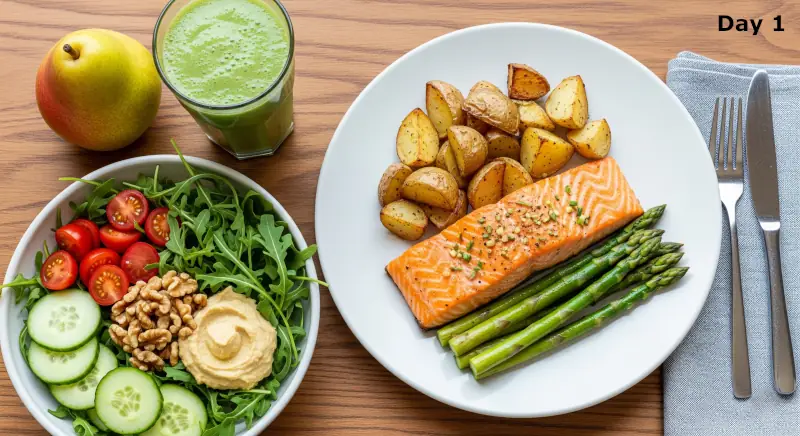
You’ll kick off your week with a burst of greens and healthy fats.
- Breakfast (333 calories): A Really Green Smoothie to energize your morning.
- Morning Snack (131 calories): A large, juicy pear.
- Lunch (422 calories): A refreshing Cucumber, Tomato & Arugula Salad with Hummus.
- Afternoon Snack (105 calories): Eight walnut halves for a healthy crunch.
- Dinner (522 calories): Delicious Garlic Butter-Roasted Salmon with Potatoes & Asparagus.
- To make it 2,000 calories: Add 1 medium orange to breakfast, add 1/3 cup unsalted dry-roasted almonds to your morning snack, plus increase to 1/4 cup walnuts, and add 1 medium apple to your afternoon snack.
Day 2: Sweetness and Satisfaction
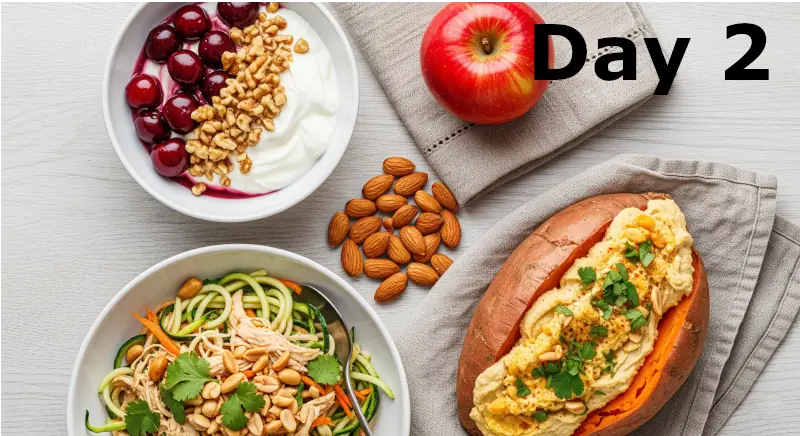
Enjoy a mix of sweet and savory to keep your taste buds happy and inflammation at bay.
- Breakfast (333 calories): Creamy low-fat plain Greek yogurt with fresh cherries and chopped walnuts.
- Morning Snack (95 calories): A medium apple.
- Lunch (347 calories): Flavorful Peanut Zucchini Noodle Salad with Chicken and a clementine.
- Afternoon Snack (206 calories): A quarter cup of unsalted dry-roasted almonds.
- Dinner (472 calories): A comforting Stuffed Sweet Potato with Hummus Dressing.
- To make it 2,000 calories: Add 3 tablespoons of natural peanut butter to your morning snack and add 1 serving of Everything Bagel Avocado Toast to dinner.
Day 3: Green Goodness and Hearty Salads
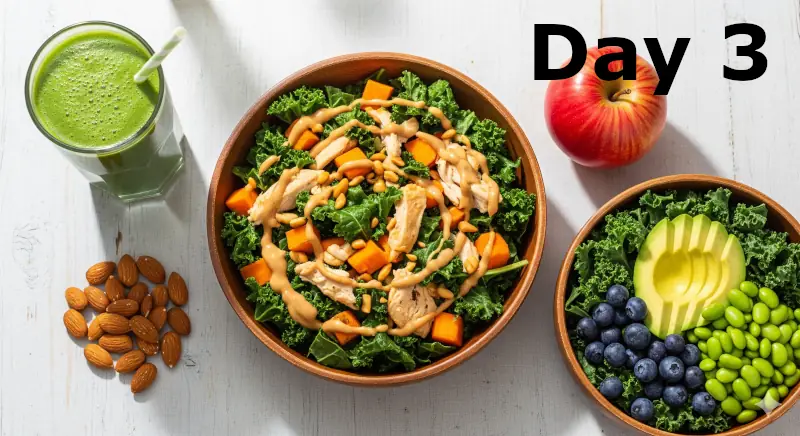
This day is full of nutrient-packed greens and a satisfying chicken salad.
- Breakfast (333 calories): Another energizing Really Green Smoothie.
- Morning Snack (206 calories): A quarter cup of unsalted dry-roasted almonds.
- Lunch (393 calories): A filling Sweet Potato, Kale & Chicken Salad with Peanut Dressing.
- Afternoon Snack (95 calories): A medium apple.
- Dinner (464 calories): A vibrant Kale & Avocado Salad with Blueberries & Edamame served with a slice of whole-wheat baguette.
- To make it 2,000 calories: Add 1 medium orange to breakfast, add 1 large pear to your morning snack, and add 3 tablespoons of natural peanut butter to your afternoon snack.
Day 4: Berries, Chicken, and Comfort
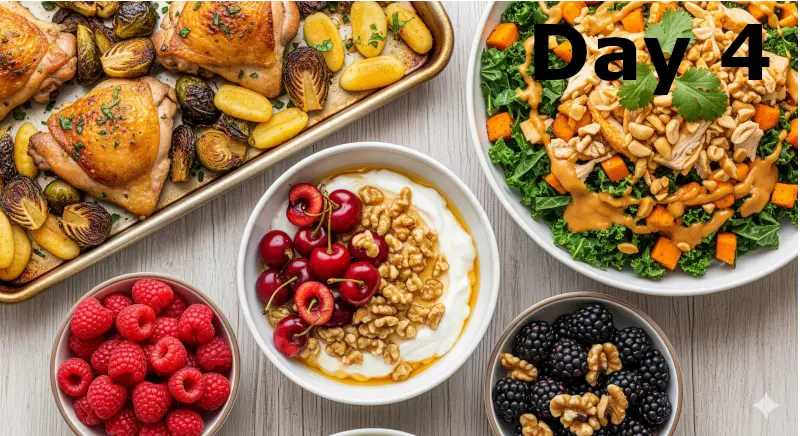
A delicious blend of sweet berries and a hearty sheet-pan dinner.
- Breakfast (333 calories): Low-fat plain Greek yogurt with fresh cherries and chopped walnuts.
- Morning Snack (64 calories): A cup of fresh raspberries.
- Lunch (393 calories): Your tasty Sweet Potato, Kale & Chicken Salad with Peanut Dressing.
- Afternoon Snack (127 calories): A cup of fresh blackberries and five walnut halves.
- Dinner (604 calories): A comforting Sheet-Pan Chicken Thighs with Brussels Sprouts & Gnocchi.
- To make it 2,000 calories: Increase to 4 tablespoons chopped walnuts at breakfast, add 1/3 cup unsalted dry-roasted almonds to your morning snack, and increase to 1/3 cup walnuts at your afternoon snack.
Day 5: Lentil Love and Fresh Salads
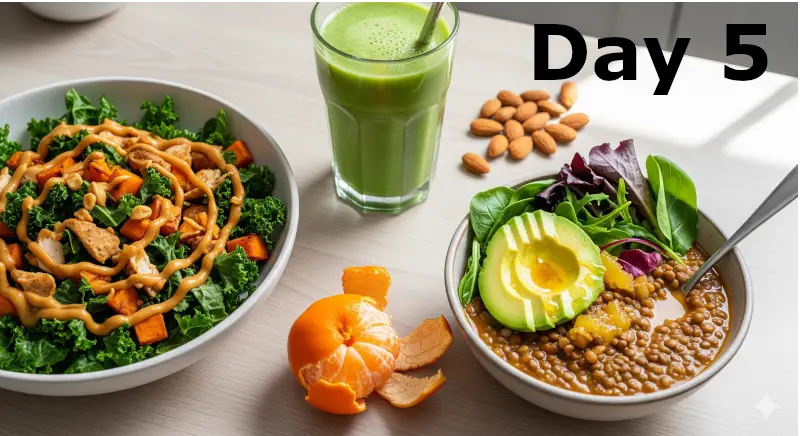
Enjoy a delicious, warming lentil soup and a fresh, bright salad.
- Breakfast (333 calories): Another Really Green Smoothie.
- Morning Snack (154 calories): Twenty unsalted dry-roasted almonds.
- Lunch (393 calories): Your delicious Sweet Potato, Kale & Chicken Salad with Peanut Dressing.
- Afternoon Snack (35 calories): A sweet clementine.
- Dinner (582 calories): A comforting bowl of Vegan Lentil Soup with mixed salad greens, sliced avocado, and a citrus vinaigrette.
- Meal-Prep Tip: Remember to reserve 2 servings of the Vegan Lentil Soup to have for lunch on Days 6 and 7.
- To make it 2,000 calories: Add 1 slice of sprouted-wheat toast with 1 tablespoon natural peanut butter to breakfast, add 1 large pear plus increase to 25 almonds at your morning snack, and increase to 1 whole avocado at dinner.
Day 6: Warming Soup and Savory Eggs
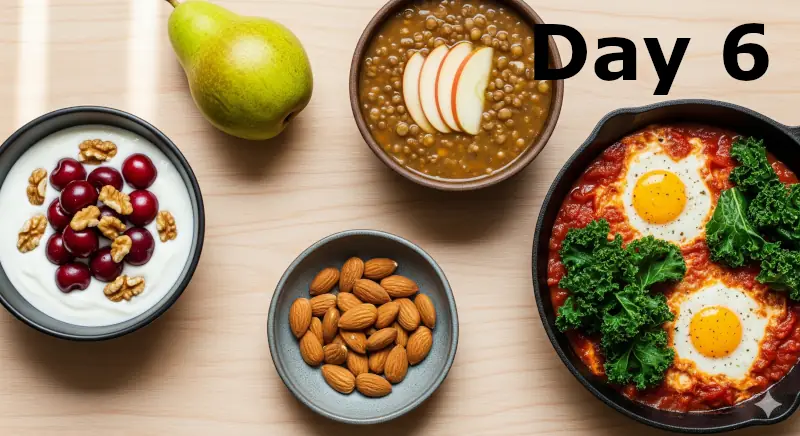
Cozy up with leftover lentil soup and a savory egg dish.
- Breakfast (333 calories): Low-fat plain Greek yogurt with fresh cherries and chopped walnuts.
- Morning Snack (131 calories): A large pear.
- Lunch (367 calories): A satisfying serving of Vegan Lentil Soup and a medium apple.
- Afternoon Snack (206 calories): A quarter cup of unsalted dry-roasted almonds.
- Dinner (440 calories): Hearty Baked Eggs in Tomato Sauce with Kale served with a slice of whole-wheat baguette.
- To make it 2,000 calories: Add 1/3 cup unsalted dry-roasted almonds to your morning snack, add 1 serving Everything Bagel Avocado Toast to lunch, and add 1 medium orange to your afternoon snack.
Day 7: Flavorful Fish and a Fresh Finish
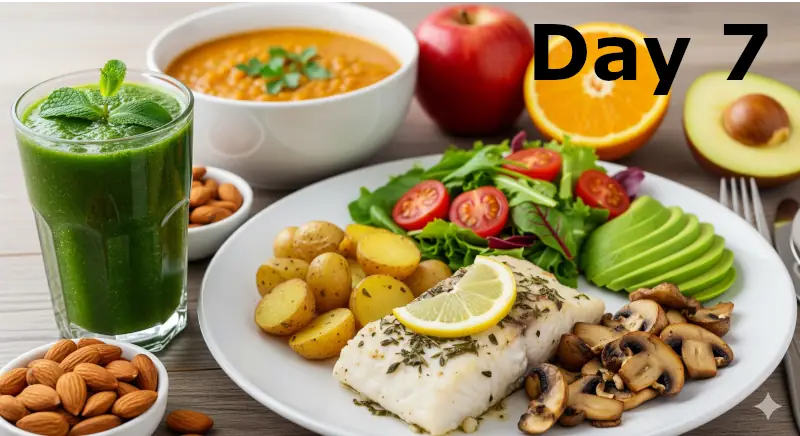
Conclude your week with a delicious fish dish and another serving of lentil soup.
- Breakfast (333 calories): Your final Really Green Smoothie for the week.
- Morning Snack (154 calories): Twenty unsalted dry-roasted almonds.
- Lunch (367 calories): The last serving of your delicious Vegan Lentil Soup and a medium apple.
- Afternoon Snack (62 calories): A medium orange.
- Dinner (586 calories): Flavorful Provençal Baked Fish with Roasted Potatoes & Mushrooms, served with mixed salad greens, sliced avocado, and a citrus vinaigrette.
- To make it 2,000 calories: Add 1 slice of sprouted-wheat toast with 1 tablespoon natural peanut butter to breakfast, add 1 large pear to your morning snack, and increase to 1 whole avocado at dinner.
Snack Ideas to Keep You Satisfied
Throughout the week, you’ll notice a variety of simple, healthy snacks integrated into the plan. These are perfect for keeping you full and nourished between meals on your inflammation diet for beginners:
- Pears
- Apples
- Walnuts
- Almonds
- Clementines
- Raspberries
- Blackberries
- Oranges
This detailed plan offers a fantastic starting point, proving that an inflammation diet for beginners can be both effective and enjoyable.
Smart Shopping & Meal Prep for Success
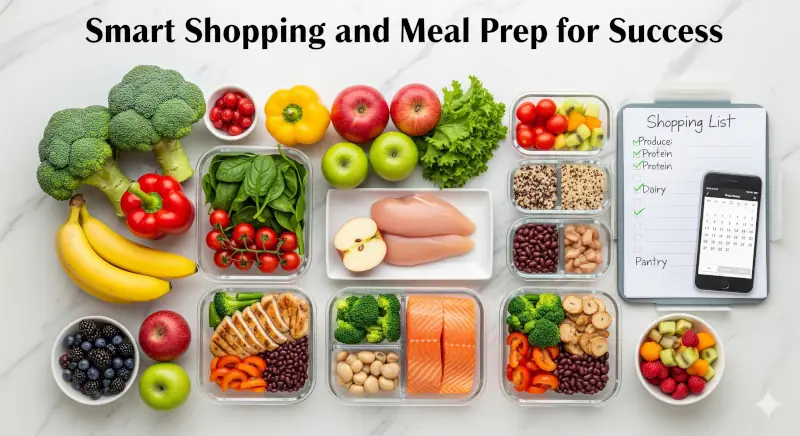
Starting any new eating plan can feel like a big step, but with a little planning, it can be incredibly easy and even fun! This section will help you get organized, making your week of anti-inflammatory eating smooth and stress-free. Having the right ingredients on hand and doing a bit of prep ahead of time are your secret weapons for success on this inflammation diet for beginners.
Essential Shopping List
Before you dive into cooking, let’s make sure your kitchen is stocked with all the wonderful ingredients you’ll need. This list is your guide to picking up everything for your 7-day plan.
Pantry Items: Your Kitchen Staples
- Extra-virgin olive oil: A cornerstone of healthy fats.
- Salt & Pepper: Essential seasonings.
- Everything bagel seasoning: For an extra flavor kick.
- Herbes de Provence: A blend of savory herbs.
- Cider vinegar: For dressings and flavor.
- Honey: A natural sweetener.
- Natural peanut butter: For delicious dressings and energy.
- Fish sauce, Hot sauce, Soy sauce: To add depth and spice to your meals.
Produce: Freshness and Color
- Mixed salad greens: The base for many healthy meals.
- Baby spinach: Versatile and nutritious.
- Asparagus: A tasty green vegetable.
- Avocados: Packed with healthy fats.
- Broccoli & Brussels sprouts: Cruciferous powerhouses.
- Potatoes (Yukon gold) & Sweet potatoes: Healthy carbohydrates.
- Cucumbers, Kale, Tomatoes, Zucchini: Fresh veggies for salads and more.
- Mushrooms, Red onion, Garlic, Cilantro, Oregano: Flavor builders.
- Fruits: Apples, bananas, blueberries, blackberries, raspberries, cherries, clementines, lemons, oranges, pears.
Grocery: Packaged Goods and Grains
- Hummus: A creamy and versatile dip.
- Canned cannellini beans & Dry lentils: Excellent sources of plant-based protein and fiber.
- Gnocchi: A delicious addition to a sheet-pan meal.
- Sun-dried tomatoes & Canned tomatoes: For rich, savory flavors.
- Grain-free granola: A good option for breakfasts or snacks.
- Whole-wheat baguette & Whole-grain bread: Healthy bread options.
- Unsalted dry-roasted almonds & Walnut halves: For healthy fats and snacks.
- Chia seeds: A great source of fiber.
- Almond milk: For smoothies and more.
- Frozen kale & Frozen shelled edamame: Convenient and nutritious additions.
Dairy & Eggs: Protein Powerhouses
- Low-fat plain Greek yogurt: A protein-rich breakfast staple.
- Eggs: Versatile and nutritious.
Meat, Poultry & Seafood: Lean Proteins
- Boneless, skinless chicken breast: A lean protein source.
- Salmon fillets: Packed with anti-inflammatory omega-3s.
Time-Saving Prep-Ahead Tips
One of the best ways to stick to your inflammation diet for beginners is to do a little bit of meal preparation when you have time. This means less cooking during busy weekdays and more time to enjoy your healthy meals.
Here are a couple of smart prep-ahead ideas from the plan:
- Sweet Potato, Kale & Chicken Salad with Peanut Dressing: This is a fantastic meal to make a larger batch of. You’ll be enjoying it for lunch on Days 2 through 5, so preparing it once saves you a lot of time and effort!
- Vegan Lentil Soup: This comforting soup is another excellent candidate for batch cooking. You can make a larger pot and reserve two servings to have for lunch on Days 6 and 7.
By taking a little time to plan and prepare, you’ll find that following this anti-inflammatory diet is not only manageable but also incredibly rewarding. You’re setting yourself up for a week of feeling good and fueling your body with the best ingredients!
Frequently Asked Questions (FAQs) About Your Anti-Inflammation Diet for Beginners
It’s natural to have questions when you start a new eating plan, especially something as beneficial as an anti-inflammatory diet. This section addresses some common questions to help you feel confident and empowered as you embark on this inflammation diet for beginners journey.
The Powerful Health Benefits of an Anti-Inflammatory Diet
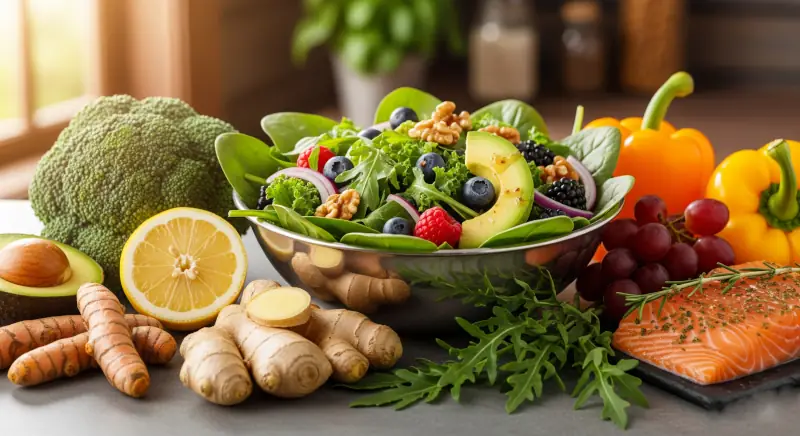
As you follow this inflammation diet for beginners, you’re doing much more than just eating healthy meals; you’re actively investing in your long-term health. The benefits of an anti-inflammatory diet extend far beyond simply reducing feelings of aches and fatigue. This way of eating is a powerful tool for wellness, designed to protect your body and boost your overall vitality.
Beyond Reducing Inflammation: A Shield for Your Health
The core goal of this diet is to reduce chronic inflammation in your body, which can be a silent driver of many health problems. But the amazing thing about an anti-inflammatory diet is that its benefits reach even further. The nutrients in these foods are protective against the development of serious diseases.
Imagine building a strong shield for your body; that’s what an anti-inflammatory diet helps you do. It provides a natural defense that guards against the development of:
- Cancer: By reducing inflammation and providing powerful antioxidants, this diet can help protect your cells from damage that can lead to cancer.
- Heart Disease: The healthy fats and fiber in anti-inflammatory foods contribute to a healthier heart, supporting good cholesterol levels and overall cardiovascular health.
This shows how truly impactful your food choices can be. Every meal on your inflammation diet for beginners is a step towards a more robust and resilient you.
Key Nutrients at Work: Your Body’s Best Friends
So, what exactly is it about these foods that makes them so powerful? It’s all thanks to an army of incredible nutrients working together in your body.
- Healthy Fats: These are superstars in fighting inflammation. You’ll find them abundantly in foods like:
- Olive oil
- Avocados
- Nuts (like walnuts and almonds). These fats are crucial for many body functions and play a direct role in calming inflammatory responses.
- Antioxidants: These compounds are like tiny heroes that protect your cells from damage caused by harmful molecules. An anti-inflammatory diet is packed with them, especially from the vast array of fruits and vegetables you’ll be enjoying:
- Beta-carotene: This gives orange vegetables (like sweet potatoes and carrots) their vibrant color and acts as a strong antioxidant.
- Glucosinolates: Found in cruciferous vegetables such as broccoli and Brussels sprouts, these are compounds with powerful protective properties.
- Anthocyanins: These are responsible for the beautiful red, blue, and purple hues in fruits and vegetables like berries, cherries, and pomegranates. They are highly effective antioxidants.
- Fiber: Many of the foods emphasized in an anti-inflammatory diet are rich in fiber. Why is fiber so important for inflammation?
- Lowering Glycemic Response: Fiber helps slow down how quickly sugar enters your bloodstream after a meal. When your blood sugar levels stay steady, it helps reduce the body’s inflammatory response.
- Gut Health: Fiber also feeds the good bacteria in your gut, which play a significant role in your immune system and overall inflammation levels.
By understanding the incredible work these nutrients do, you can truly appreciate the profound impact of your food choices. This inflammation diet for beginners is a delicious way to give your body the best tools to heal, protect itself, and thrive.
Conclusion: Embrace Your Anti-Inflammatory Journey
You’ve just taken an important step on your path to better health! Understanding and trying an inflammation diet for beginners is a powerful way to take control of how you feel every day. This 7-day plan is not just about eating; it’s about nourishing your body, reducing discomfort, and boosting your overall well-being with delicious, wholesome foods.
Think of this plan as your friendly starting point. It’s been carefully put together by registered dietitians who want to make healthy eating easy and enjoyable. You’ve learned about the amazing power of fruits, vegetables, healthy fats, and whole grains, and how to spot foods that might be working against you. You’ve got a clear meal plan, a helpful shopping list, and smart meal-prep tips to guide you every step of the way.
Remember, this journey is personal. While this plan offers a fantastic roadmap, it’s also important to use it as inspiration and adjust it to fit your individual nutritional needs and preferences. Don’t be afraid to mix and match meals, try new anti-inflammatory recipes, and discover what truly makes your body feel its best.
Every meal is an opportunity to make a positive choice for your health. By embracing this inflammation diet for beginners, you’re empowering yourself to live with less pain, more energy, and a greater sense of vitality. So, take what you’ve learned, step into your kitchen with confidence, and start enjoying the wonderful benefits of an anti-inflammatory lifestyle today! Your body will thank you.
2 Sources:
Noble Home Remedies relies on peer-reviewed studies, academic research institutions, and medical associations for accuracy and reliability while avoiding tertiary references. Our editorial policy provides more information about how we ensure our content is accurate and up-to-date.
- 7-Day Anti-Inflammatory Meal Plan for Beginners, Created by a Dietitian
https://www.eatingwell.com/article/7894310/anti-inflammatory-meal-plan-for-beginners/ - 7-Day Meal Plan to Fight Inflammation: Recipes and More
https://www.healthline.com/health/rheumatoid-arthritis/seven-day-meal-plan
Trust in your purchase:
Every product featured on our site has been carefully researched and selected based on quality, customer ratings, and positive reviews to ensure you receive excellent value for your money.
Please note:
This post contains affiliate links. If you make a purchase through these links, we may earn a small commission at no additional cost to you. This helps support our site and allows us to continue bringing you valuable content. Thank you!
Thank you for your precious time spent with NobleHomeRemedies.
You may also like:
Real Food Diet
The Best Real Food Diet: 10 Steps Guide to a Healthier Life Are you tired…
Do This For 1 Minute For 7 Days
Practice this for 7 days and you will see the changes in your life. Start…
Subway Calorie Calculator
Easy Subway Calories Calculator | Calories in Subway Sandwich Are you a Subway lover who…
Owala Water Bottle – FreeSip
Staying hydrated is crucial for our overall health and well-being. Yet, with our busy lives,…
Benefits of Exercising
Incredible Benefits of Exercising: Supercharge Your Life Life can get pretty busy, can’t it? Between…
Poop Health – What Does Poop Taste Like?
What Does Poop Taste Like?: 7 Poop Secrets and Your Health What Does Poop Taste…

